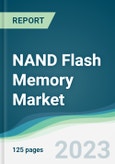The NAND flash memory market is estimated to grow at a CAGR of 4.35% to reach US$91.698 billion in 2028 from US$68.062 billion in 2021.
The market is being driven by the increasing use of computers and smartphones, which is also pushing the consumption of NAND flash memory. For instance, Micron estimates that the typical smartphone has 43 GB of NAND flash storage and that this amount will increase significantly over the next four years. According to the business, flagship devices will have one terabyte of flash storage by 2021, with the typical phone having 142 GB of NAND storage. Additionally, increasing market innovation is also projected to drive up demand for NAND flash memory throughout the projection period.Increasing Demand for Smartphones
Flash memory storage has become a crucial component of smartphones. The tremendous increase in standard smartphone capacity is largely the reason for an extraordinary rise in demand for NAND flash. Smartphones with NAND flash memory have substantially faster web browsing, email loading, gaming, and even social networking sites like Facebook. Further, with the advent of 5G wireless communication, smartphone usage is expected to rise, boosting the demand for the newest models to consistently set the standard higher. For instance, the Ericsson Mobility report predicts that by the end of 2024, 5G subscribers would make up 55% of all mobile subscriptions in the North American region. Additionally, as per the International Telecommunication Union, 66% of the world's population, or around 5.3 billion people, use the Internet. This reflects an increase in growth rate from 5.1 percent for 2020–2021 to 6.1 percent for 2021.Increasing Demand for Other Electronic Devices
other consumer products, including tablets, cameras, automobile systems, industrial machinery, sensors, and medical appliances, rely on flash memory, which is built into CPUs and stores data and code. As the demand for huge data processing for artificial intelligence and machine learning applications rises, the trend toward flash-based storage will only continue to expand. Since Windows 11 PCs will need new microprocessors with more memory, which will drive the expansion of the NAND flash memory industry, the new Microsoft operating system, which will be released in October 2021, will help push NAND sales.Restraints in the Market
The cyclic nature of the demand and supply of the non-volatile storage device coupled with other trade restrictions has resulted in major market players present in China cutting off their production, which is expected to hinder market growth. For instance, in April 2023, Samsung Electronics cut off its production of NAND flash memory to 6, 20, 000 units in Xian, China production facility which represented a 5, 34% decrease in its NAND production in comparison to Q4 of 2021. Also, in October 2022, the trade restriction imposed by the US on the supply of NAND flash memory restrained the production scale of major China-based NAND flash supplier Yangtze Memory Technologies Co. Ltd. The US restrictions would prevent YMTC from gaining a competitive advantage in the memory business.Asia Pacific is Expected to Grow Considerably
Asia Pacific is expected to hold a significant share of the NAND flash memory market during the forecast period. The growing semiconductor production coupled with booming consumer electronics consumption mainly smartphones and laptops are majorly driving the market demand for NAND flash memory in the region. The booming electronics consumption in China coupled with rapid urbanization have provided a positive outlook to the market demand for NAND flash memory. For instance, according to the “Mobile Economy Outlook 2023” report issued by the GSM Association, China’s strength of mobile phone subscribers is expected to reach 1.33 billion in 2023 representing a 3.1% increase over 2022. Furthermore, as per the same source, the percentage share of smartphone users will account for up to 93% in 2023.Key Market Developments
- Floadia announced the development of flash memory in December 2021 that can store 7bpcfor a decade at 150°C. To keep data for extended periods without power, Floadia's novel memory can hold more charges per cell and has longer retention than conventional flash memory.
- In June 2021, Micron Technology revealed new memory and storage products that can support enterprises that rely on data as the data economy expands. The data bottleneck in current computers' storage, memory, and processing solutions was addressed by the development of the new flash memory and dynamic RAM (DRAM) chips.
Segmentation:
By Type
- Single Level Cell (SLC)
- Multi-Level Cell (MLC)
- Triple Level Cell (TLC)
By Structure
- 2D Structure
- 3D Structure
By Application
- Smartphone
- SSD
- Memory Card
- Tablet
- Other Applications
By Geography
- Americas
- USA
- Others
- Europe Middle East and Africa
- UK
- Germany
- France
- Others
- Asia Pacific
- China
- Japan
- Taiwan
- South Korea
- Indonesia
- Thailand
- Others
Table of Contents
1. INTRODUCTION
2. RESEARCH METHODOLOGY
3. EXECUTIVE SUMMARY
4. MARKET DYNAMICS
5. NAND FLASH MEMORY MARKET ANALYSIS, BY TYPE
6. NAND FLASH MEMORY MARKET ANALYSIS, BY STRUCTURE
7. NAND FLASH MEMORY MARKET ANALYSIS, BY APPLICATION
8. NAND FLASH MEMORY MARKET ANALYSIS, BY GEOGRAPHY
9. COMPETITIVE ENVIRONMENT AND ANALYSIS
10. COMPANY PROFILES
Companies Mentioned
- Samsung Electronics Co. Ltd
- KIOXIA Corporation
- Micron Technology Inc
- SK Hynix Inc.
- SanDisk Corp. (Western Digital Technologies, Inc)
- Powerchip Technology Corporation
- Cypress Semiconductor Corporation
- GigaDevice Semiconductor
- Winbond Electronics Corporation
- ATP Electronics Inc
Methodology

LOADING...
Table Information
| Report Attribute | Details |
|---|---|
| No. of Pages | 125 |
| Published | October 2023 |
| Forecast Period | 2021 - 2028 |
| Estimated Market Value ( USD | $ 68.06 Billion |
| Forecasted Market Value ( USD | $ 91.7 Billion |
| Compound Annual Growth Rate | 4.3% |
| Regions Covered | Global |
| No. of Companies Mentioned | 10 |









